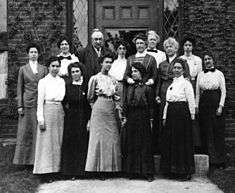Harvard Computers

Edward Charles Pickering (director of the Harvard Observatory from 1877 to 1919) decided to hire women as skilled workers to process astronomical data. Among these women were Williamina Fleming, Annie Jump Cannon, Henrietta Swan Leavitt and Antonia Maury. This staff came to be known as "Pickering's Harem" or, more respectfully, as the Harvard Computers.[1] This was an example of what has been identified as the "harem effect" in the history and sociology of science.
It seems that several factors contributed to Pickering's decision to hire women instead of men. Among them was the fact that men were paid much more than women, so he could employ more staff with the same budget. This was relevant in a time when the amount of astronomical data was surpassing the capacity of the Observatories to process it.[2]
The first woman hired was Williamina Fleming, who was working as a maid for Pickering. It seems that Pickering was increasingly frustrated with his male assistants and declared that even his maid could do a better job. Apparently he was not mistaken, as Fleming undertook her assigned chores efficiently. When the Harvard Observatory received in 1886 a generous donation from the widow of Henry Draper, Pickering decided to hire more female staff and put Fleming in charge of them.[3]

As a result of the work of the women "computers", Pickering published in 1890 the first Henry Draper Catalog, a catalog with more than 10,000 stars classified according to their spectrum. Pickering decided to hire Antonia Maury, a graduate from Vassar College, to reclassify some of the stars. Maury decided to go further and improved and redesigned the system of classification. It was published in 1897, but was largely ignored. Afterwards Pickering decided to hire Cannon, a graduate of Wellesley College, to classify the southern stars. As Maury had done, Cannon also ended up redesigning the classification system of the spectra and developed the Harvard Classification Scheme, which constitutes the basis of the system used today.
Henrietta Swan Leavitt's insight that all the variable stars in the Small Magellanic Cloud are roughly the same distance from Earth, led to her discovering a direct relationship between the period of Cepheid variable stars and their intrinsic brightness.[4] This discovery, in turn, led to the modern understanding of the true size of the universe, and Cepheid variables are still an essential tool for the measurement of cosmological distance.
Although some of Pickering's female staff were astronomy graduates, their wages were similar to those of unskilled workers. They usually earned between 25 and 50 cents per hour, more than a factory worker but less than a clerical one.[5]
References
- ↑ Larsen, Kristine M. (2007). Cosmology 101. Greenwood Publishing Group. ISBN 0313337314.
- ↑ Rossiter, Margaret W. (2006). Women Scientists in America (Volume I). JHU Press. ISBN 0801857112.
- ↑ http://www.cnet.com/news/how-a-team-of-19th-century-women-mapped-the-cosmos/ The 19th century women who catalogued the cosmos], Michelle Starr, Cnet News, March 7, 2016
- ↑ Miss Leavitt in Pickering, Edward C. "Periods of 25 Variable Stars in the Small Magellanic Cloud" Harvard College Observatory Circular 173 (1912) 1–3.
- ↑ Johnson, George (2006). Miss Leavitt's Stars. W. W. Norton & Company, Incorporated. ISBN 0393328562.
| Wikimedia Commons has media related to Harvard Computers. |